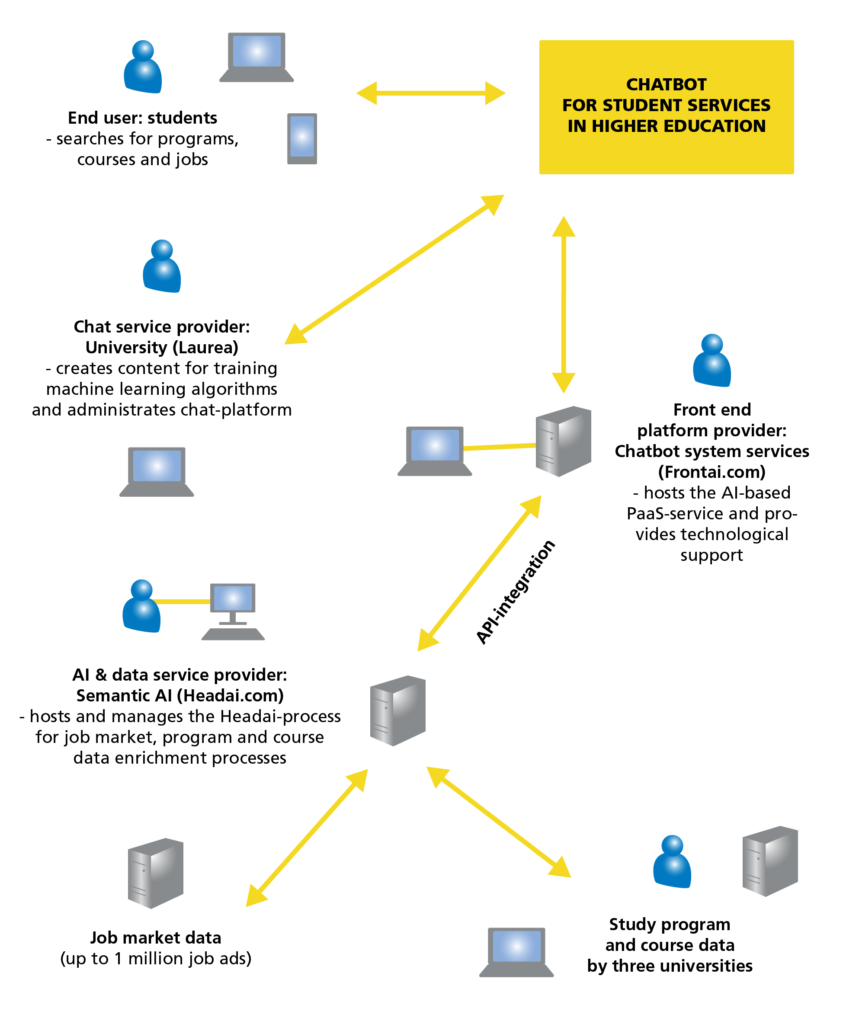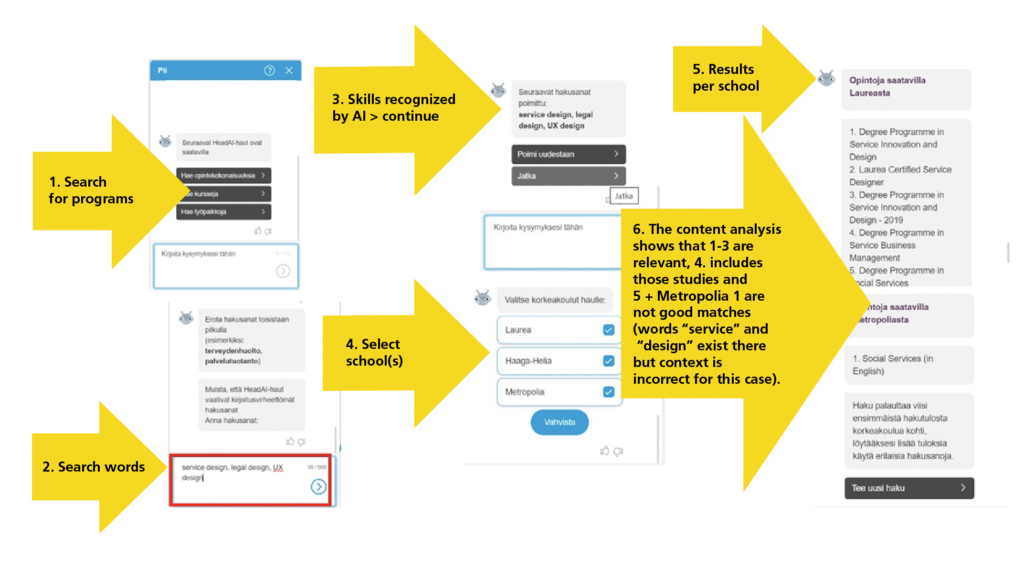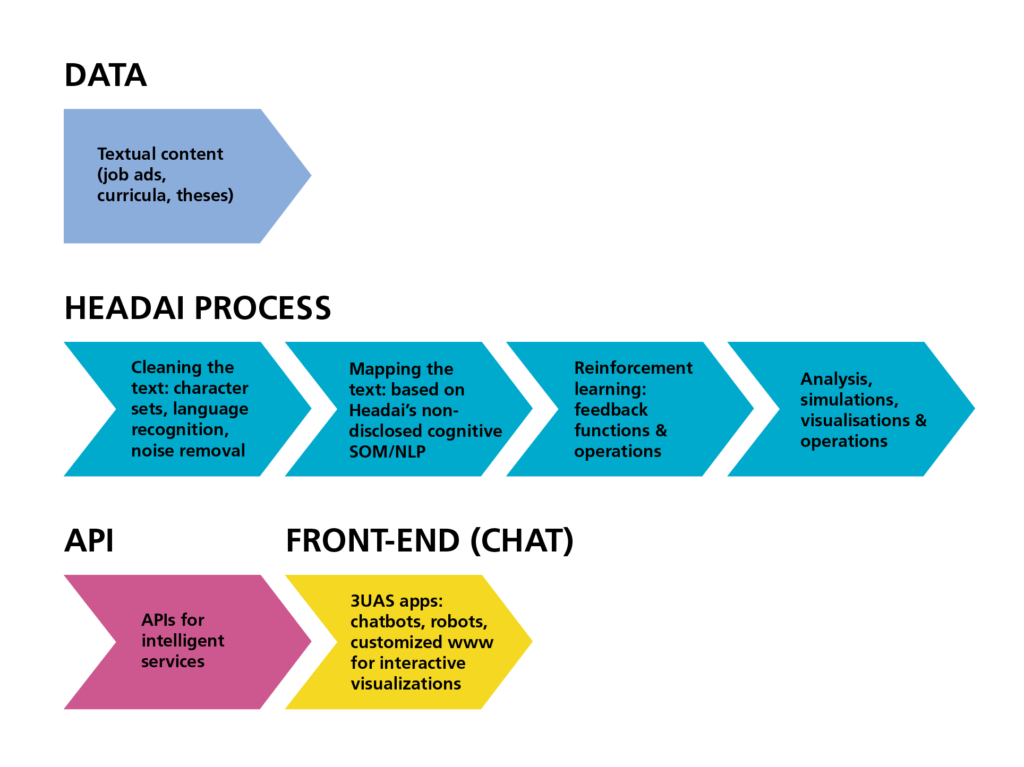Abstract
In this study, we examine how to adopt AI-based conversational chat in higher education and discuss our experiences and findings in integrating external datasets with machine learning-based chat conversations. The adoption of artificial intelligence in higher education institutes and universities is just starting, and scientific literature in this field is limited. In this study, we conceptualise and model the adoption and integration experience using our case experiment. This article provides new knowledge for automating student services by adopting AI-based service chats that enrich conversations by integrating external data services into chat platforms. This can allow higher education institutes and universities to conserve human resources and allow them to provide uninterrupted student services 24/7. We recommend further research on the methods and practices that promote the integration of various AI-based services from the perspective of the API economy.
Keywords: artificial intelligence, higher education, service chat, natural language processing (NLP), chatbot
Introduction
Higher education institutes working with service companies are rapidly implementing artificial intelligence-enhanced (AI-enhanced) conversational chat services for helping students. The ultimate aim of AI-enhanced chats is to reduce the need for personal human assistance while still addressing students’ conventional information needs. These advanced conversational agents are able to tailor their responses to student queries by identifying the context of the conversation and satisfying students’ needs better than classic FAQ sections and non-contextual chatbots.
This article presents and discusses our experiences in adopting conversational chat for students in higher education in Finland. An enhanced conversational chat service that was integrated with semantic AI-data services was delivered to students of Laurea University of Applied Sciences through a pilot program. The level of adoption and automation differentiates these AI-enhanced conversational chats from traditional chat services. Natural language processing (NLP) analytics using machine learning algorithms interpret users’ intentions and tailor responses based on intention and context.
This study also describes how an AI-based service can be established within an ecosystem. The chat service was created in the 3UAS ecosystem, which brings together universities and companies specialising in AI. In the demonstration described in this study, the service was created as a joint effort among three universities in close cooperation with two companies who provided a variety of services used as modules within the integrated application. The services used were the Front.ai platform (a personalised chat service), the Headai database and the NLP platform.
Here, we provide a case experiment for using Front.ai and the Headai platform and its corresponding database in creating personalised service chats for students. Front.ai uses NLP and machine learning to enable human-like conversations. It also combines semantic neurocomputing and learning algorithms to create conversations that adapt to the students’ personal information needs. In the case experiment, conversation and information richness were improved by integrating the external data management service into the chat platform. We used Headai Microcompetences (www.headai.com), semantic AI services that provide databases, and NLP analytics for job market data. The experiment also combined course and program information from the three universities to generate the results of the selected searches in the chat interface. The case experiment was conducted as part of the 3AMK AI-team research and development tasks. The 3AMK AI-team consists of staff members of Haaga-Helia, Laurea and Metropolia Universities of Applied Sciences in the Helsinki metropolitan area, Finland.
We aim to answer the following research questions: What is the optimal AI-setup, namely what have we learned while implementing the integration of AI-based service chat to AI-based data management services, and what are the recommendations for similar technology-adopting processes?
Literature review
Higher education institutes are adopting AI for various needs, ranging from the personalisation of learning and teaching to curriculum planning and the automation of administrative tasks (Ketamo et al., 2019). In this study, we view AI as a computer agent that observes and collects data from the environment, implements a function that analyses data for achieving the best expected outcomes related to its goals, and adapts to changes by learning from new situations (Russell & Norvin, 2016). The adoption of AI in education is in its initial stage (Renz et al., 2020). The rapidly developing ability of AI will create new personalised learning and educational services. AI-enhanced personalisation is a potential value-creating mechanism for education (Chassignol et al., 2018), although the diversity of learners and support for informational learning are significant educational challenges. AI is often thought to simulate human thinking and behaviour, although it is still far from human capabilities such as meta-cognition, intuitive psychology and affection (Lake et al., 2017). However, AI-based personalisation technologies (Tiihonen & Felfernig, 2017) could be adopted in the educational context.
Personalised learning and adaptive learning often refer to the same phenomena. These terms are used synonymously in technology-enhanced learning literature (van Velsen et al., 2008; Xie et al., 2019), although personalised learning is also used as an “umbrella concept” (van Velsen et al., 2008). Although technology-enabled personalised learning is a popular research stream, the majority of current scientific research in the field focuses on traditional computers or devices (Xie et al., 2019); limited research has been conducted on advanced technologies or smart devices in education (Ketamo, 2003).
Very little research has been conducted on using AI in continuous learning by a collaboration between higher education and industry. Higher-order thinking and communication have received little attention in technology-enabled personalised learning (Xie et al., 2019). Also, insufficient data collection techniques are a bottleneck for providing instructions closely concerned with learners’ experiences and learning contexts (Xie et al., 2019). This requires context-aware user data collection, which is still insufficiently researched in personalisation (Hong et al., 2009). The development and management of data governance models and practices is one of the most important development actions in adopting AI (Aunimo et al., 2019), including in educational research settings.
AI-enhanced adaption or personalisation provides new practices to create value for students, teachers and administrators in education (Chassignol et al., 2018; Renz et al., 2020). Personalised services tailor the guidance or instruction based on the students’ preferences, profiles, information needs or progress in the conversation. Also, advanced chats interpret the students’ contexts or affective experiences and tailor the conversation to their undefined information needs (Alnahdi, 2019). Thus, AI provides new research opportunities from the viewpoint of personalised learning in automating student services in higher education. A literature review (Xie et al., 2019) indicates that research on the adoption of AI to personalised learning is insufficient, creating a justifiable research gap.
Although the literature on AI-enhanced personalization and educational services (e.g. Chassignol et al., 2018; Renz et al., 2020) provides initial understanding of opportunities to adopt AI to education, research on the system design and development in that field is scant. Furthermore, literature on the AI-based personalization (Ketamo, 2003; Tiihonen & Felfernig, 2017) has emphasized adaptive systems, less is known about how to design and develop those system for education. Thus, this study contributes to filling the aforementioned research gaps from the AI-based personalization system design and development perspective in the context of integrated service chat.
Methods
To answer the research questions, we created a case project related to the AI-based service chat with the external database. We focused on the adopting experiences of AI-based service chat, where the conversation is enriched by integrating the external AI-based data service. Since the aim of this experiment was to develop a new understanding of the adoption of AI-enhanced chats to student services, we used the case study approach (Eisenhardt & Graebner, 2007). The qualitative case study allowed us to create a study of real-life phenomena and experiences (Gummesson, 2000). The research method also employs the features of conceptual research (Meredith, 1993) in a case-study research setting, since we analysed experiences by describing architectural conceptualisation, technological integration processes and implementation experiences in the multi-actor environment. We emphasise the networked working model, where several actors or providers integrate their resources for co-creating new AI-based services in higher education. This is essential feature in developing AI-based services with the platform economy approach.
In addition, an abductive qualitative research approach (Dubois & Gadde, 2002) was applied in creating theoretical and practical contribution for the debate of platform economy. The abductive research approach enables researchers to build explanations and conceptual understanding while analyzing the case experiences in an iterative manner. In this research approach, we simultaneously processed prior literature and analyzed empirical data. Our design and development process consisted of the following phases; concept and architecture definition, configuration of cloud-based chat service, creating training content for chat’s machine learning, requirement specification for Application Programming Interface (API) integration, development of API-integration, testing the system and reporting the experiments.
Results
Applications and actor roles in the system architecture
This AI-based service chat consists of three main technologies and ecosystem platforms: 1) the website of Laurea University of Applied Sciences, which works as a delivery channel for the chat service, 2) the Front.ai chatbot service that uses boost.ai’s technologies for creating conversational chat services for the users and 3) Headai’s semantic AI-services for external data management. The applications and actor roles in the system architecture are presented in Figure 1.
The key user roles in managing the chatbot system are (1) end users, (2) chat service providers, (3) front-end chat-platform technology providers and (4) data and AI service providers. The chat service deploys cloud-based technology that the users access through a website where the chat is integrated. Databases for courses and jobs are maintained externally by companies (for example, duunitori.fi) and organisations (including universities). This data is downloaded into the AI system at regular intervals (job market) or during catalogue updates (course and study programs) by the AI service provider (here, Headai). The AI service provider’s API allows the chatbot service to send and receive data while the end user is chatting. The API uses the standard HTTP POST method which, in addition to user query data, also includes authorisation tokens provided by the AI service provider.

Use case descriptions
We created three use cases in implementing chat for the students. The first use case is search for programs, which provides information related to the study programs, such as service design or UX design. The second use case focused on search for courses, covering courses available in the three universities considered. The third use case was search for jobs, which deals with open job positions.

The main view of the chat shows three available searches. If students select “search for programs” (Fig. 2), they need to type a few keywords related to their intent (phase 2). The machine learning algorithms of the chat platform identify the intention or need and connect the inserted keywords of intent to the relevant terms of skills (phase 3). Next, the user selects the university with the relevant study programs (phase 4). Finally, the chat displays the best matches from the databases of three different universities in the chat window (phase 5).
The chat platform runs similar processes if students select other use cases. The “search for jobs” analyses Headai’s job market database, which consists of a total of 2 million job advertisements; one single search session uses only a small part of the dataset, depending on the intention of the user. The “search for courses” use case performs NLP analyses of the course databases of the three universities, returning the best possible matches related to the keywords of the users’ intentions. From the user’s point of view, interaction with the chat is simple and quick. However, the chat enriches its information processes by searching the external databases through API-integration. Figure 2 shows the information-enriching process, in which the Front.ai chat is integrated into the API of the Headai platform.
API-integration from the chat to the external databases
As mentioned earlier, an important part of the study was to describe how this service can be a joint effort of an ecosystem. Thus, the service was not created using just one AI platform; instead, services of different companies were combined through API integration. This approach is not optimal and certainly not the most streamlined, but we gained valuable experience in how this relatively complex service can be realised in practise within an ecosystem.

The data collected for the AI in this case are based merely on job openings, UAS curricula, personal CVs and a selection of web contents. Since the data here are partially semi-structured and partially free text, they require preprocessing to an applicable format suitable for machine learning – in this case, reinforcement learning (Wiering & van Otterlo, 2012).
The result is a graph that provides a platform for elaborate queries over the API. These queries, along with the GUI developed by the UAS consortium, can then be interactively visualised to support decision-making on course selection and job requirements matching.
An important outcome of this study was that all software services provided by the participating companies were successfully integrated through APIs and the pipeline described in Fig. 3. As trivial as this sounds, a successful outcome was not guaranteed because integration of multiple non-disclosed commercial services is more difficult than creating a streamlined service on the top of just one platform optimised for the purpose. However, the technical objectives were achieved, and the study also serves as a demonstration of how a small-scale API economy works: A modular AI service can be created using commercial and non-disclosed services of several companies. In our case, the technical solution was not optimised; in further ecosystem efforts, the APIs between different services could be streamlined.
Discussion
To answer our research questions, we analysed and described our development and integration experiences related to AI-based student services. In this study, we showed that adopting AI-based services in higher education requires the competence and resource integration of several actors across organisational boundaries. Implementing, configuring and setting up an AI-based service chat requires collaboration between chat platform experts and educational specialists who know the students’ information needs. However, our experiences also show that the most challenging and time-consuming part is the technological integration of chat platforms and external data management services.
The chat is the user interface for using external data services, and information needs to be displayed in a user-friendly format to the small chat window. The window should also allow users to navigate within their information search journey. Thus, we recommend allocating plenty of time for integration and usability testing. In this experiment, we did not use anonymised data, as the anonymisation may decrease information richness and make data analytics and the use of mined information more complicated (Alamäki et al., 2019). Also, when using and collecting user information, we need to take into account privacy issues; however, organisations can enhance users’ willingness to provide consent for data collection by providing useful information as a trade-off (Mäki & Alamäki, 2019).
We found this case experiment to be promising, yet the build phase was slower than expected. The use cases were defined and the team had built several large-scale IT systems earlier; still, adopting new technology skills and building a demo using external APIs with part-time developers was relatively slow. The development team leaned heavily on supplier-side support (Front.ai and Headai.com). Therefore, adequate resourcing of skilled developers with dedicated time and partnering is recommended for future deployments.
The findings align with previous research (Alamäki et al., 2018) that shows that when designing new AI-enabled services and their ecosystems, we need to integrate various actors and resources into value chains and ecosystems. This study also supports the research of Quan and Sanderson (2018) by providing empirical evidence that we are dealing with an ecosystem perspective in designing AI-enabled services. The goals of this case study were achieved, and the chat works in real-life usage settings on the Laurea website. This case study also demonstrates how a small-scale API economy is designed and implemented; it shows that a modular AI service can be created using commercial and non-disclosed services of several companies. With a modular service design relying on standardized API calls, it’s possible to combine AI functionalities from different service providers and easily replace the provider if necessary. This is beneficial for the upkeep costs and time.
Conclusions
The results of this case study provide new insights into phenomena that have been under-researched in the context of AI-enhanced educational services. We recommend that in the future AI ecosystem designs, APIs between different services be more streamlined. The API economy increases application diversity (Lee & Ha, 2018). Thus, integrating and streamlining information processing between AI systems is a crucial factor in successfully designing new AI-powered services in multi-provider ecosystems where the various actors have integrated their resources and competences. Our work contributes towards the aim of creating personalized, easy-to-use and modular AI-powered tools for students in higher education. The use of APIs in integrating AI-based services calls for further research in design, technology and especially their business outcomes (Ofoeda et al., 2019). Therefore, additional research on business benefits when designing and implementing AI-powered services is needed. Furthermore, more research is needed to understand how students experience the interaction with AI-based chat that enriches its information from the external database. Basic limitations of this case study include the relatively small test group, which limits the generalizability of the results.
References
- Alamäki, A., Rantala, T., Valkokari, K., & Palomäki, K. (2018). Business roles in creating value from data in collaborative networks. In L. M. Camarinha-Matos, H. Afsarmanesh, & Y. Rezgui (Eds.), Collaborative networks of cognitive systems:19th IFIP WG 5.5 Working conference on virtual enterprises, PRO-VE 2018 (pp. 595–606). Springer.
- Alamäki, A., Aunimo, L., Ketamo, H., & Parvinen, L. (2019). Interactive machine learning: Managing information richness in highly anonymized conversation data. In L. M. Camarinha-Matos, H. Afsarmanesh, & D. Antonelli (Eds.), Collaborative Networks and Digital Transformation: The Proceeding of 20th IFIP WG 5.5 Working Conference on Virtual Enterprises, PRO-VE 2019 (pp. 173–183). Springer.
- Alnahdi, A. (2019). The impact of the use of artificial intelligence in the education sector. International Journal of Artificial Intelligence and Machine Learning, 1 (4), 1, 8.
- Aunimo, L., Alamäki, A. V., & Ketamo, H. (2019). Big data governance in agile and data-driven software development: A market entry case in the educational game industry. In Big Data Governance and Perspectives in Knowledge Management (pp. 179–199). IGI Global.
- Chassignol, M., Khoroshavin, A., Klimova, A., & Bilyatdinova, A. (2018). Artificial Intelligence trends in education: A narrative overview. Procedia Computer Science, 136, 16–24.
- Dubois, A., & Gadde, L. E. (2002). Systematic combining: an abductive approach to case research. Journal of Business Research, 55:7, 553–560.
- Eisenhardt, K. M., & Graebner, M. (2007). Theory building from cases: Opportunities and challenges. Academy of Management Journal, 50(1), 25–32.
- Gummesson, E. (2000). Qualitative Methods in Management Research. 2nd ed., Sage Publications, Thousand Oaks, CA.
- Hong, J., Suh, E. H., Kim, J., & Kim, S. (2009). Context-aware system for proactive personalized service based on context history. Expert Systems with Applications, 36(4), 7448–7457.
- Ketamo, H. (2003). An adaptive geometry game for handheld devices. Journal of Educational Technology & Society, 6(1), 83–95.
- Ketamo, H., Moisio, A., Passi-Rauste, A., & Alamäki, A. (2019). Mapping the future curriculum: Adopting artificial intelligence and analytics in forecasting competence needs. Proceedings of the 10th European Conference on Intangibles and Intellectual Capital ECIIC 2019, 144–153. Academic Conference Publishing International.
- Lake, B. M., Ullman, T. D., Tenenbaum, J. B., & Gershman, S. J. (2017). Building machines that learn and think like people. Behavioral and brain sciences, 40. E253.
- Lee, K., & Ha, N. (2018, January). AI platform to accelerate API economy and ecosystem. In 2018 International Conference on Information Networking (ICOIN), 848–852. IEEE.
- Meredith, J. (1993). Theory building through conceptual methods. International Journal of Operations & Production Management, 13(5), 3–11.
- Mäki, M., & Alamäki, A. (2019). Data privacy concerns throughout the customer journey and different service industries. In L. M. Camarinha-Matos, H. Afsarmanesh, & D. Antonelli (Eds.), Collaborative Networks and Digital Transformation: The Proceeding of 20th IFIP WG 5.5 Working Conference on Virtual Enterprises, PRO-VE 2019, (pp. 516–526). Springer.
- Ofoeda, J., Boateng, R., & Effah, J. (2019). Application programming interface (API) research: A review of the past to inform the future. International Journal of Enterprise Information Systems (IJEIS), 15(3), 76–95.
- Quan, X. I., & Sanderson, J. (2018). Understanding the artificial intelligence business ecosystem. IEEE Engineering Management Review, 46(4), 22–25.
- Renz, A., Krishnaraja, S., & Gronau, E. (2020). Demystification of artificial intelligence in education–how much AI is really in the educational technology? International Journal of Learning Analytics and Artificial Intelligence for Education (iJAI), 2(1).
- Russell, S. J., & Norvig, P. (2016). Artificial intelligence: a modern approach. Pearson Education Limited.
- Tiihonen, J., & Felfernig, A. (2017). An introduction to personalization and mass customization. Journal of Intelligent Information Systems, 49(1), 1–7.
- Xie, H., Chu, H. C., Hwang, G. J., & Wang, C. C. (2019). Trends and development in technology-enhanced adaptive/personalized learning: A systematic review of journal publications from 2007 to 2017. Computers & Education, 140, 103599.
- van Velsen, L., van Der Geest, T., Klaassen, R., & Steehouder, M. (2008). User-centered evaluation of adaptive and adaptable systems: A literature review. The knowledge engineering review, 23(3), 261.
- Wiering, M., & van Otterlo, M. (Eds.). (2012). Reinforcement learning: State of the art. Vol. 16, Springer-Verlag.
